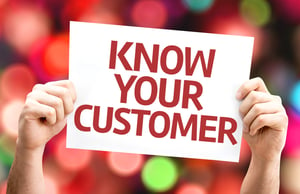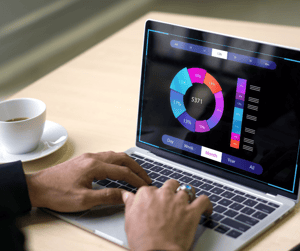How Does Social Media Help Businesses Grow?
It’s more important than ever for businesses to utilize social media.

It’s a common question among business owners: How can I grow my business?
A business online presence used to be enough, but not anymore. In today’s business environment, you have to navigate and utilize online resources to maximize your advantages in the marketplace.
Let’s face it … business has changed, and it isn’t turning back. The process by which people - and I do mean people since businesses don’t do online searches - research the products and services that they are interested in purchasing has changed. If your company does not recognize this shift in behavior, you will lose business.
That’s because buyers complete 60% of their buying cycle before they even contact your company!
If potential customers are doing research before they even decide to contact you, you need a solid web presence. A website is only the beginning, however. Your website must offer value, and you must have a plan in place to drive customers to your site - and keep them there.
Here are the top 5 ways to do just that and in the process, grow your small business:

One of the most critical things you must do to grow your business is to know your customers.
Who are they? What are their pain points? What challenges do they have? Where and how do they shop?
You need to develop a strong picture of your ideal customers, or who we call buyer personas, in order to market to them more effectively.
According to Hubspot, the top priority for marketers is generating leads.
Understanding who your target audience is in great detail helps you solve this challenge and create useful and relevant content that is valuable to your ideal customer.
How do you determine a buyer persona? Determining your buyer persona involves gathering information about your target audience to create a detailed profile that represents your ideal customer. Here are some steps to help you create a buyer persona:
By following these steps, you can develop accurate and effective buyer personas that will guide your marketing efforts and help you better connect with your target audience.
Need more help? Our article Buyer Persona | What Are They And Why Do I Need Them? helps you figure out who your ideal customers are, their needs and what they do when they’re online so you can determine who you should be gearing your website and its content toward.
Does your website make the cut? Evaluating your current website with a critical eye is important in determining whether you need a redesign. After all, 90% of searchers haven’t made up their minds about a brand before starting their search, according to Hubspot.
need a redesign. After all, 90% of searchers haven’t made up their minds about a brand before starting their search, according to Hubspot.
First impressions are crucial, and unfortunately, websites are subject to snap judgments by users. In fact, it takes just .05 seconds for a user to form an opinion about your site. That means your site must not only offer value in content, but be organized and visually appealing.
It won’t matter how many visitors you drive to your site if, when they get there, they immediately move on to another option.
Extra tip: While you’re at it, consider evaluating your mobile site as well. Statistics show 52% of customers are less likely to engage with a company because of a bad mobile experience, and 57% of internet users say they won’t recommend a business with a poorly designed website on a mobile device.
Considering that global mobile advertising spending is expected to exceed $300 billion by this year, can you afford not to focus on your mobile site as well?
Creating content aimed at your ideal customers will give you substantially more opportunities for your customers to find you.
Blogs, ebooks, case studies, white papers and charts can be used to draw in your ideal customers and give them something of value. All this content creates organic search results for you. After all, 70% of the links search users click on are organic - not paid (Marketing Sherpa). So, you want to make sure you have high-quality content to offer.
Another form of engaging content are videos. Nearly 56% of marketers reported that they planned to invest in short-term video marketing in 2024. If you explore this form of content, you don’t have to make long videos in an effort to provide more content. Nearly a third of marketers say the optimal video is just one to three minutes long, and 96% say 10 minutes is as long as a video should run.
Depending on your target audience, you can also explore other types of content, such as podcasts. In fact, nearly a quarter of all marketers leverage podcasts or other audio content as part of their long-term digital marketing strategies. Ad spending in the digital audio advertising market is expected to grow to a whopping $13 billion by 2028.
While content marketing is crucial to growing your business, not everyone has the same marketing budget as multi-million-dollar companies. For small business owners, however, there are several approaches that aren’t as costly or timely. Hiring a marketing agency is an affordable way to save you money and time by creating content for you that’s tailored to your buyer persona. We’ll explore what this may look like for you later in this article.

Chances are you have a Facebook page for your business. In fact, Hubspot reports that Facebook is the most popular social media platform that marketers use currently because of its ROI. However, if you don’t use Facebook to its maximum potential, your page will simply sit there waiting for someone to stumble upon it.
The same goes for other social media options you have, whether it’s Twitter, LinkedIn, or Pinterest. They can all bring you qualified leads and can be a cost effective growth strategy. Here is where knowing your audience is especially beneficial.
Here are some key Hubspot marketing statistics about some of the different social media platforms available to you:
Even when you target the right social media channel for your business, you must take the important step of creating quality posts. After all, your social media strategy is only as good as the content you create, and your goal should be to educate, inform or entertain your prospects.
Don’t forget to take advantage of marketing tools available to you, such as Facebook Lead ads, post boosts and other social media advertising opportunities. You can read more about how to use social media effectively in our article 5 Ways To Use Social Media To Ignite Your Lead Generation.
By the way, if you have high-quality content, it’s more likely to be shared on social media, extending your reach and further opening up the possibilities for lead generation.
Paid advertising can be a powerful tool for accelerating the growth of your business by reaching highly targeted audiences and driving relevant traffic to your products or services.
However, understanding your audience is critical to using paid advertising effectively since it allows you to tailor your campaigns to resonate with their interests, behaviors and preferences. In the end, this will maximize the return on your advertising investment.
Knowing where your customers spend their time will also help you decide how to advertise and where to advertise. One of the decisions you’ll have to make is whether you invest in pay-per-click (PPC) or paid social media advertising.
Pay-Per-Click (PPC) is often associated with search engine advertising like Google Ads and is based on user intent. This means that ads are shown to users who are actively searching for specific keywords or phrases related to your product or service.
PPC campaigns allow you to target users based on their search queries, demographics, location and other factors. By bidding on keywords relevant to your business, you can ensure that your ads appear to users who are most likely to be interested in what you offer.
Paid social media advertising, on the other hand, is based on user interests and directly corresponds to the social media channels your potential customers use. Examples of paid social media advertising are Facebook Ads, Instagram Ads and YouTube Ads.
These platforms allow you to target users based on their demographics, interests, behaviors and connections. Paid social media campaigns also enable you to reach a highly targeted audience, but the targeting is based on user profiles and behaviors rather than their immediate search intent.
As you can see, with both types of paid advertising, it’s critical to know your customers’ interests. However, pay-per-click is based on intent, whereas paid social media is based on interests.
When deciding between PPC and paid social media advertising, this should be the first thing you think about. For optimal campaign performance, align your choice with your audience’s browsing habits and online behaviors. For example, if you remodel bathrooms, showing people before and after images of your work in Facebook Ads could be the best option for you because people can see your work and be tempted into contacting you, even if they were just thinking of doing a remodel. Whereas, if you are a business looking for an immediate need, like a burst pipe in your home, then services like Google Ads may be a better option because the user intends to purchase right away.
Need more ideas on how to grow your business? We have a bonus tip for you and it involves how to take your marketing to the next level … through inbound marketing.
Inbound marketing incorporates website design, buyer personas, calls-to-action, landing pages, blogging, content creation, strategic planning, email marketing and analyses.
All of it is designed to maximize and deliver measurable results in line with your business goals.
Traditional tactics don’t work like they used to. Outbound marketing tactics like cold calls and print ads use a one-way communication method that no longer generates quality leads. The proof is in the numbers:
Only 18% of marketers say outbound practices provide the highest quality leads for sales. If you’re relying on outbound marketing to drive business growth, you likely need to change your business plan to include a more effective strategy.
So how does inbound marketing deliver the goods? First, it’s important to determine whether inbound marketing is right for your business. If so, inbound marketing will:
Hiring a marketing agency, especially one that uses inbound strategies, will provide you with expert guidance and support in implementing a comprehensive inbound marketing strategy tailored to your business needs.
By leveraging a firm’s expertise in website design, content creation, keyword research and strategic planning, you can attract quality leads, nurture them through the sales funnel, and ultimately achieve your business goals more effectively.
With inbound marketing, you’ll benefit from a more targeted approach that focuses on building relationships and delivering valuable content to your audience, leading to higher engagement, conversion rates and return on investment.
Have additional questions about how inbound marketing works? You can get your questions answered in our article, Inbound Marketing For Business.
While some companies still operate “business as usual,” those that are taking action to grow their business through effective and proven methods are moving light-years ahead of their competition.
Change isn’t always easy, and neither is navigating the internet and using it to your advantage. However, businesses that embrace new technology and employ the tools necessary to make their business goals a reality will generate higher-quality leads and establish themselves as leaders in their industry.

It’s more important than ever for businesses to utilize social media.

If you are searching for ways to generate more leads for your business, it’s more than likely that you’ve come across the term “inbound marketing.”...

Marketing is the lifeblood of your small business. If you’re looking to grow your customer base, increase revenue, or simply grow brand awareness, a...